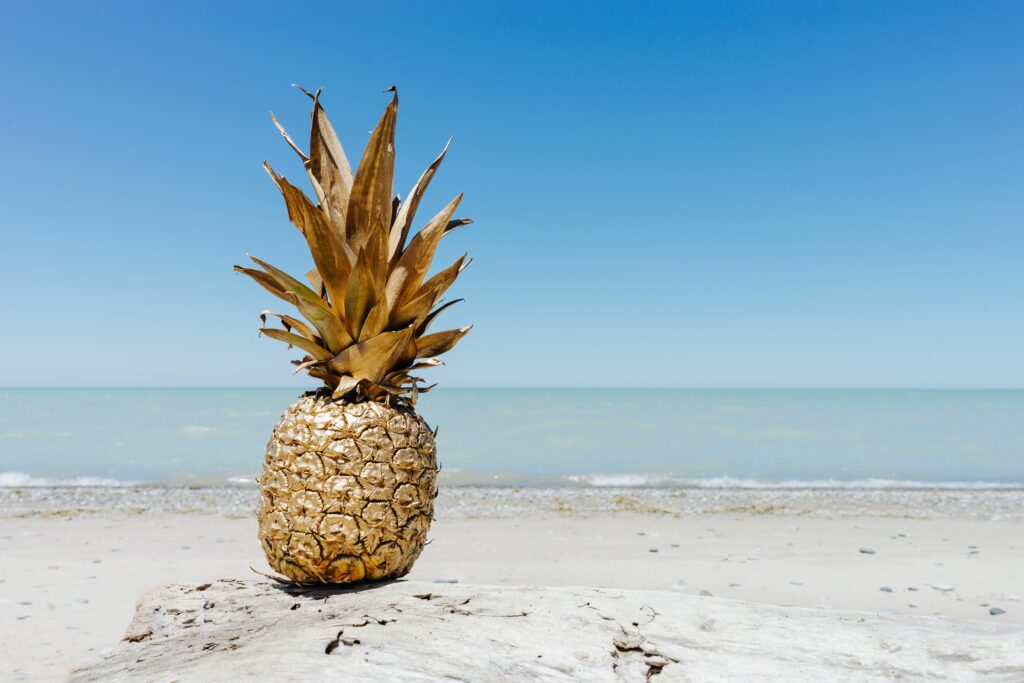When it comes to selecting and storing a pineapple, proper care and attention are essential to ensure that the fruit remains fresh and flavorful. Fresh pineapple is highly perishable and can easily bruise or ferment if not stored correctly. To select a ripe pineapple, one should look for fresh-looking leaves, a plump and heavy fruit, and a strong, sweet aroma that is not fermented. The color of the pineapple may vary between green and yellow-gold, depending on the variety. Once the pineapple is selected, it should be stored properly to maintain its freshness. Storing the whole pineapple in a perforated plastic bag in the refrigerator can extend its lifespan, while trimming and cutting the fruit should be stored in an airtight container, covered in juice, and consumed within five to seven days. By following these guidelines, one can enjoy a perfectly ripe and delicious pineapple every time.
Pineapple Selection
Pineapples are tropical fruits known for their sweet and tangy flavor. When selecting a pineapple, there are several factors to consider to ensure you pick the best fruit.

Appearance and Leaves
The appearance of a pineapple can provide valuable information about its freshness and ripeness. Look for pineapples that have green, fresh-looking leaves in a small, compact crown. A leaf should be easy to remove if the pineapple is fully ripe. Avoid pineapples with leaves that are wilted or brown, as this may indicate an overripe or old fruit.
Smell and Aroma
One of the key indicators of a ripe pineapple is its smell and aroma. A fresh pineapple should have a strong sweet aroma, indicating its juiciness and ripeness. Avoid pineapples that have a fermented or sour smell, as this may indicate that the fruit is overripe or beginning to rot.
Fruit Texture
When selecting a pineapple, it’s important to consider its texture. A ripe pineapple should feel plump and heavy when held. Avoid pineapples that feel too soft or mushy, as this may indicate that the fruit is overripe. The texture should be firm with just a slight give when pressed.
Color
The color of a pineapple can vary depending on the variety, but it can still provide some clues about its ripeness. Look for pineapples that have a vibrant color, whether it’s green or yellow-gold. Avoid pineapples with dull, brownish, or grayish color, as this may indicate that the fruit is past its prime.
Checking the Bottom
Another important aspect to consider when selecting a pineapple is checking its bottom. Gently press the bottom of the pineapple with your thumb and see if it yields to medium pressure. If it feels too soft or squishy, it may be a sign of overripeness. Additionally, check for any indications of mold or discoloration on the bottom.

Avoiding Signs of Overripeness
To ensure that you select a ripe and fresh pineapple, it’s crucial to avoid any signs of overripeness. Dark eyes, soft spots, and yellowed leaves are all indicators of a pineapple that is past its prime. Avoid pineapples that exhibit these signs and opt for ones that have vibrant colors, firm textures, and a sweet aroma.
Preparing the Pineapple
Once you have selected and brought home a ripe and fresh pineapple, it’s time to prepare it for consumption. Here are some steps to follow for peeling and coring a pineapple.
Peeling and Coring
Start by removing the crown and the base of the pineapple using a sharp, serrated knife. Then, standing the pineapple upright, slice off the skin in a downward vertical motion, following the natural curvature of the fruit. Ensure that you slice far enough to remove the woody eyes of the pineapple. If needed, you can use the knife tip or the tip of a peeler to dig out any remaining eyes.
Preserving Juice
To preserve the juice that may escape while slicing the pineapple, trim it on a platter to collect any juices. Don’t discard the pineapple skins just yet, as they still hold some juice that can be squeezed out.
Trimming the Core
The center core of the pineapple is tough and fibrous, so it is usually trimmed away before using the rest of the pineapple flesh. Use a sharp knife to cut out the core from each pineapple slice. The remaining pineapple flesh can then be cut into desired shapes, such as chunks or rings, for consumption or further recipes.
Pineapple Storage
After preparing the pineapple, it’s important to store it properly to maintain its freshness and flavor. Keep the following storage tips in mind to maximize the shelf life of your pineapples.
Perishability of Fresh Pineapple
Fresh pineapple is quite perishable and can spoil quickly if not stored correctly. It bruises easily despite its seemingly armored exterior and will start to ferment if kept at room temperature for too long. It’s essential to consume fresh pineapple within a short period to avoid waste and ensure optimal flavor.

Storing at Room Temperature
If you plan to consume the pineapple within two days, it can be stored at room temperature. However, keep in mind that storing at room temperature will increase the acidity level of the pineapple but will not improve its sweetness. It’s best to consume the pineapple as soon as possible for the best taste.
Refrigeration and Shelf Life
To extend the lifespan of the pineapple, refrigeration is recommended. Place the whole pineapple in a perforated plastic bag and store it in the refrigerator. This can help preserve the pineapple for three to five days. However, once the pineapple has been trimmed and cut, it should be stored in an airtight container, covered in juice, and refrigerated. This way, it can be stored for five to seven days.
Freezing Freshly Cut Pineapple
If you have freshly cut pineapple that you want to preserve, freezing is an option. Peel, core, and cut the pineapple into chunks, then place them in airtight plastic bags or covered containers with their natural juice. The pineapple can be frozen for up to six months, but keep in mind that it may lose some flavor during the freezing process.
Canned Pineapple Storage
Canned pineapple is a convenient alternative to fresh pineapple and has a longer shelf life. It is available in various forms, such as slices, chunks, crushed, and juice. Once opened, leftover canned pineapple should be refrigerated in its juice, stored in a covered container, and consumed within a week. Unopened canned pineapple can be stored in a cool, dry cabinet for up to one year.
Other Uses for Pineapple
In addition to enjoying pineapple fresh, there are many other delicious ways to incorporate this tropical fruit into your meals and beverages. Here are some creative uses for pineapple.
Pineapple Tepache
Pineapple Tepache is a traditional Mexican fermented pineapple drink that is easy to make at home. It requires minimal ingredients, including pineapple peels, brown sugar, and spices. Tepache is a refreshing and slightly tangy beverage that is popular during hot summer months.
Pineapple Casserole
Pineapple Casserole is a unique and delicious side dish that combines the sweetness of pineapple with the savory flavors of cheese and buttery cracker crumbs. It is often served as a holiday or potluck dish and pairs well with baked ham or roasted chicken.
Pineapple Sangria
Pineapple Sangria is a tropical twist on the classic wine-based cocktail. It combines pineapple juice, white wine, rum, and a variety of fresh fruits to create a refreshing and fruity drink. Pineapple Sangria is perfect for summer parties or gatherings.
Pineapple Salsa
Pineapple Salsa is a vibrant and flavorful topping that can be used in various dishes. It combines diced pineapple with jalapeno, red onion, cilantro, lime juice, and spices to create a sweet and spicy condiment. Pineapple salsa pairs well with grilled meats, fish tacos, or as a dip with tortilla chips.
Pineapple Tea
Pineapple Tea is a soothing and aromatic beverage that can be enjoyed hot or cold. It is made by steeping pineapple peels in hot water and adding sweeteners like honey or sugar to taste. Pineapple tea is known for its natural sweetness and tropical aroma.
With these creative uses, you can explore different ways to enjoy pineapple beyond its traditional form.
Conclusion
Selecting and storing pineapples properly is essential to ensure that you enjoy the best quality and flavor. When selecting a pineapple, consider its appearance, smell, fruit texture, color, and the condition of the bottom. Preparing a pineapple involves peeling, coring, and trimming the core. Proper storage techniques include refrigeration, freezing, and canned pineapple storage. Additionally, exploring other uses for pineapples, such as in Tepache, casseroles, sangrias, salsas, and teas, can provide new and exciting ways to incorporate this tropical fruit into your meals and beverages. By following these guidelines, you can make the most out of your pineapple and savor its delicious taste.
